Overview
The main focus of this article is on the essential steps veterans need to take to secure a nexus letter, a critical document for VA disability claims. We understand that this process can feel overwhelming. That's why we emphasize the importance of a well-crafted nexus letter in establishing a connection between a veteran's health condition and military service. It's vital that qualified professionals write this letter.
To help you navigate this journey, we provide a step-by-step guide to facilitate the acquisition process. Remember, you are not alone in this. We're here to help you every step of the way.
Introduction
Navigating the complexities of obtaining a nexus letter can feel overwhelming for veterans seeking the benefits they truly deserve. We understand that this crucial document serves as a vital link between a service member's medical condition and their military service. Yet, many face significant challenges in securing it. By exploring essential steps and best practices, we aim to provide you with the tools needed to streamline the process and enhance your chances of a successful VA claim.
What are the key elements to consider? How can you effectively overcome common obstacles in your journey? You're not alone in this experience, and together, we can navigate these challenges.
Turnout: Streamlining Nexus Letter Acquisition for Veterans
For former service members, navigating the process of obtaining a nexus letter can be overwhelming. Turnout is here to change that with the integration of AI technology and dedicated advocacy. With Jake, the AI case quarterback, individuals can confidently and efficiently navigate the complexities of the VA system.
This innovative approach not only speeds up the acquisition process but also ensures that former service members receive the essential support they need, including assistance with obtaining their nexus letter, to secure their benefits effectively. By combining AI capabilities with compassionate human supervision, Turnout enhances the overall experience, making it easier for veterans to access the benefits they have rightfully earned.
We understand that the journey can feel daunting, but you are not alone. Assisting more than 2 million service members in navigating the VA process, Turnout's impact is significant. Our efforts simplify workflows and reduce the bureaucratic hurdles often associated with traditional agencies, ultimately leading to better outcomes for those who have served.
Let us help you on this journey. Together, we can ensure that you receive the benefits you deserve.
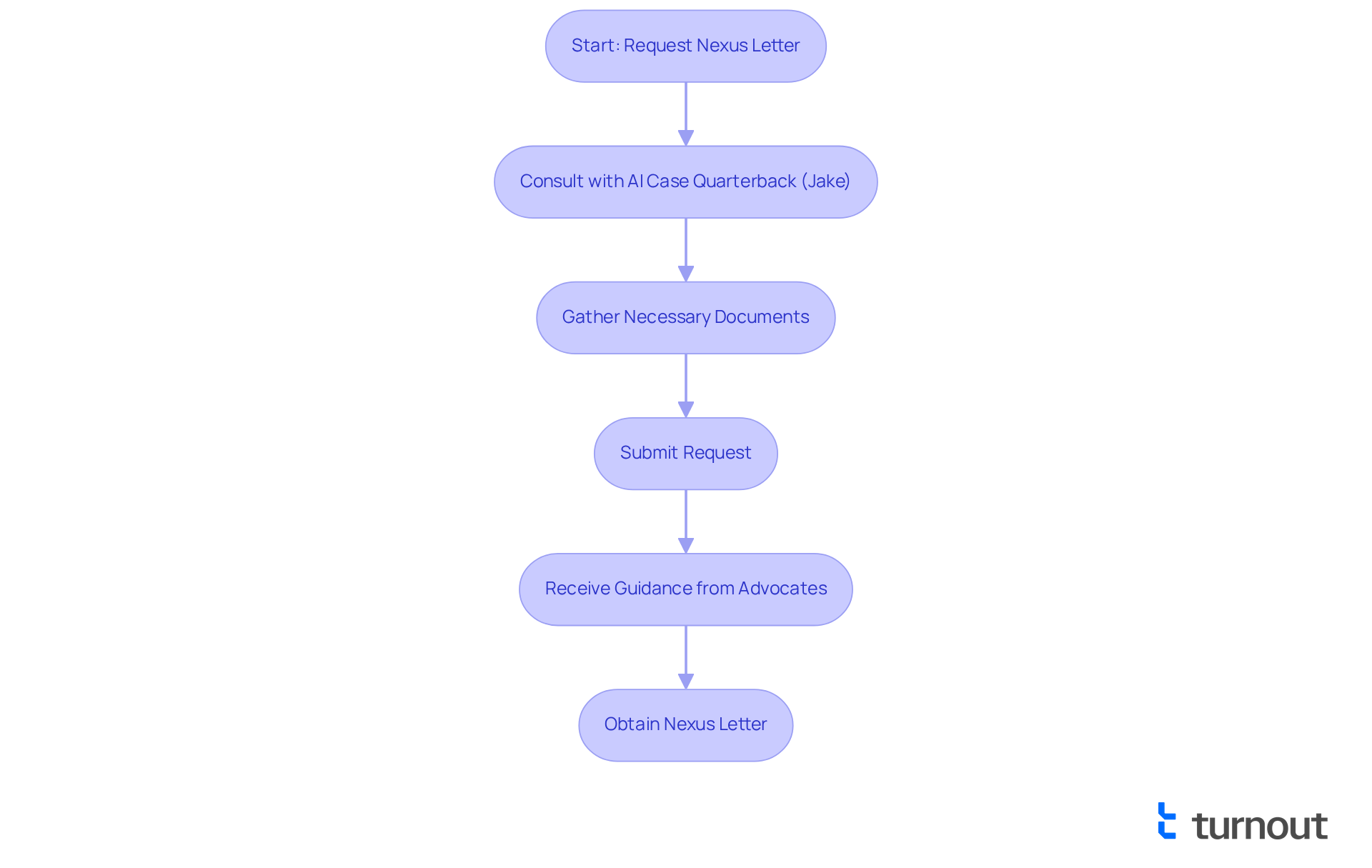
Definition of a Nexus Letter: What Veterans Need to Know
A nexus letter is a formal medical document that establishes a vital connection between a service member's current health condition and their military service. This nexus letter is essential for VA disability requests, as it provides the necessary evidence to support the claim that the condition is related to service. Unfortunately, many former service members face denied claims due to the absence of a nexus letter or because it was not properly composed. This highlights the importance of having a well-crafted nexus letter.
Veterans should know that a strong nexus letter can significantly enhance their chances of receiving benefits. It provides expert medical testimony through a nexus letter that links their health issues directly to their service. However, obtaining a solid connection document can be challenging due to doctors' busy schedules. Therefore, we encourage former service members to seek guidance from knowledgeable experts to ensure their nexus letter is crafted correctly.
Understanding this definition is the first step for former service members looking to manage their applications effectively. You're not alone in this journey, and we're here to help you navigate the process with confidence.
Key Components of a Nexus Letter: Essential Elements for Success
Creating a well-crafted document is essential for veterans seeking support. We understand that navigating this process can be overwhelming. To help you, consider including these key elements:
- Identification of the veteran and their medical condition.
- A clear nexus letter that connects the condition to military service.
- The medical professional's qualifications.
- Supporting evidence from medical records.
These components are crucial for making your nexus letter convincing and impactful. Remember, you are not alone in this journey, and we're here to help you every step of the way.
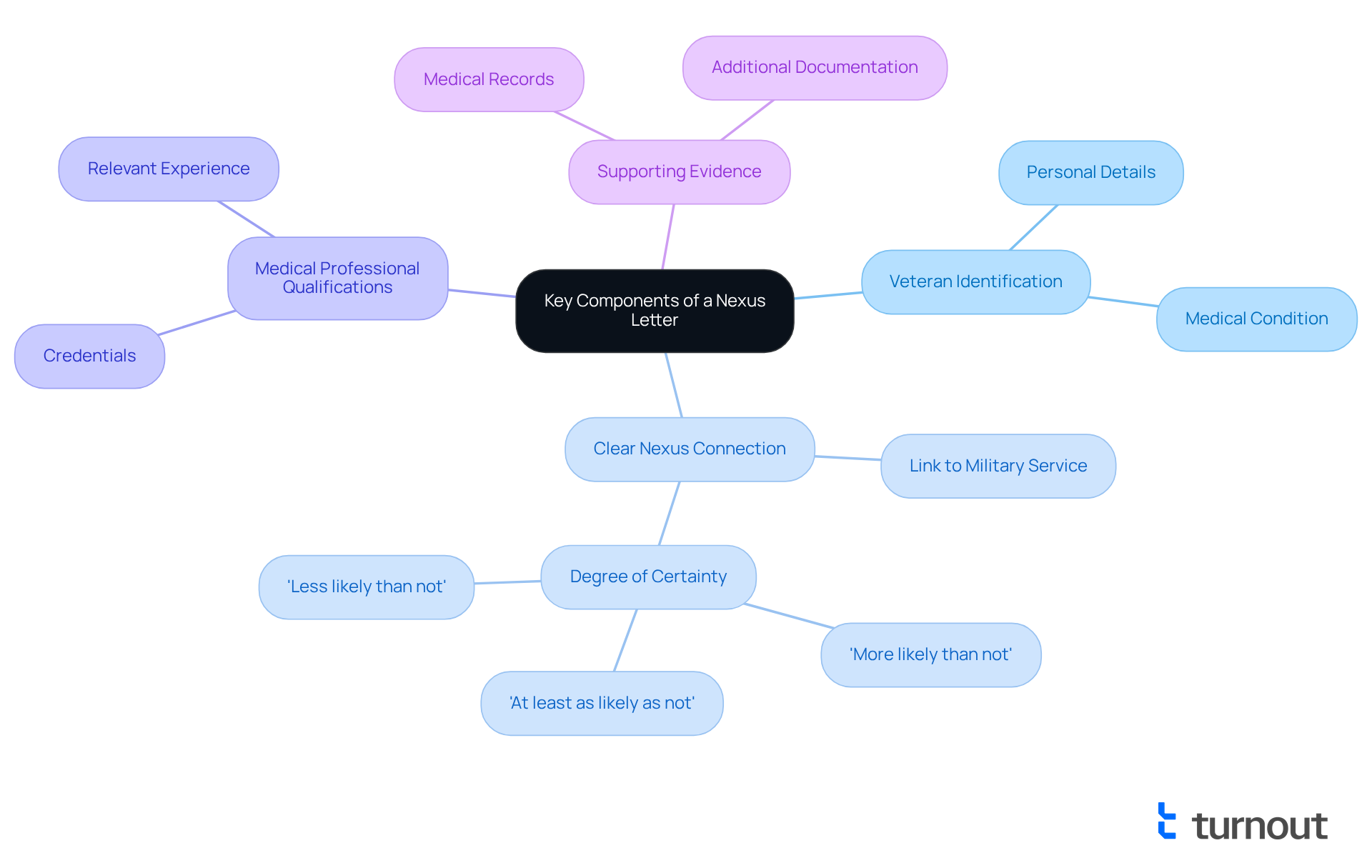
When to Obtain a Nexus Letter: Timing Your Request
Veterans, we understand that navigating the application process can be challenging. Prioritizing the early acquisition of a nexus letter can make a significant difference. Ideally, this letter should accompany your initial request or be submitted during the appeals process if your request has been denied. Prompt submission provides the VA with essential evidence to support your claim from the start, potentially leading to a quicker resolution.
It's common to feel discouraged, especially considering that roughly 30% of disability applications are initially rejected. This is why a nexus letter that is carefully constructed is crucial in addressing such refusals. Many former service members have experienced positive outcomes by submitting the nexus letter early, which highlights its significant impact on the acceptance of requests. As one veteran noted, 'Including my nexus letter with my initial submission made all the difference; it demonstrated to the VA I was serious about my case.'
Furthermore, as emphasized by Turnout, 'The quality of a nexus letter can determine the success of a case.' This proactive approach not only enhances your chances of approval but also helps you avoid the frustration of prolonged waiting periods, which often accompany claims lacking sufficient supporting documentation. To ensure a robust nexus letter, we encourage service members to collect relevant medical records and paperwork prior to their meeting with a healthcare professional. Remember, you are not alone in this journey; we're here to help you every step of the way.
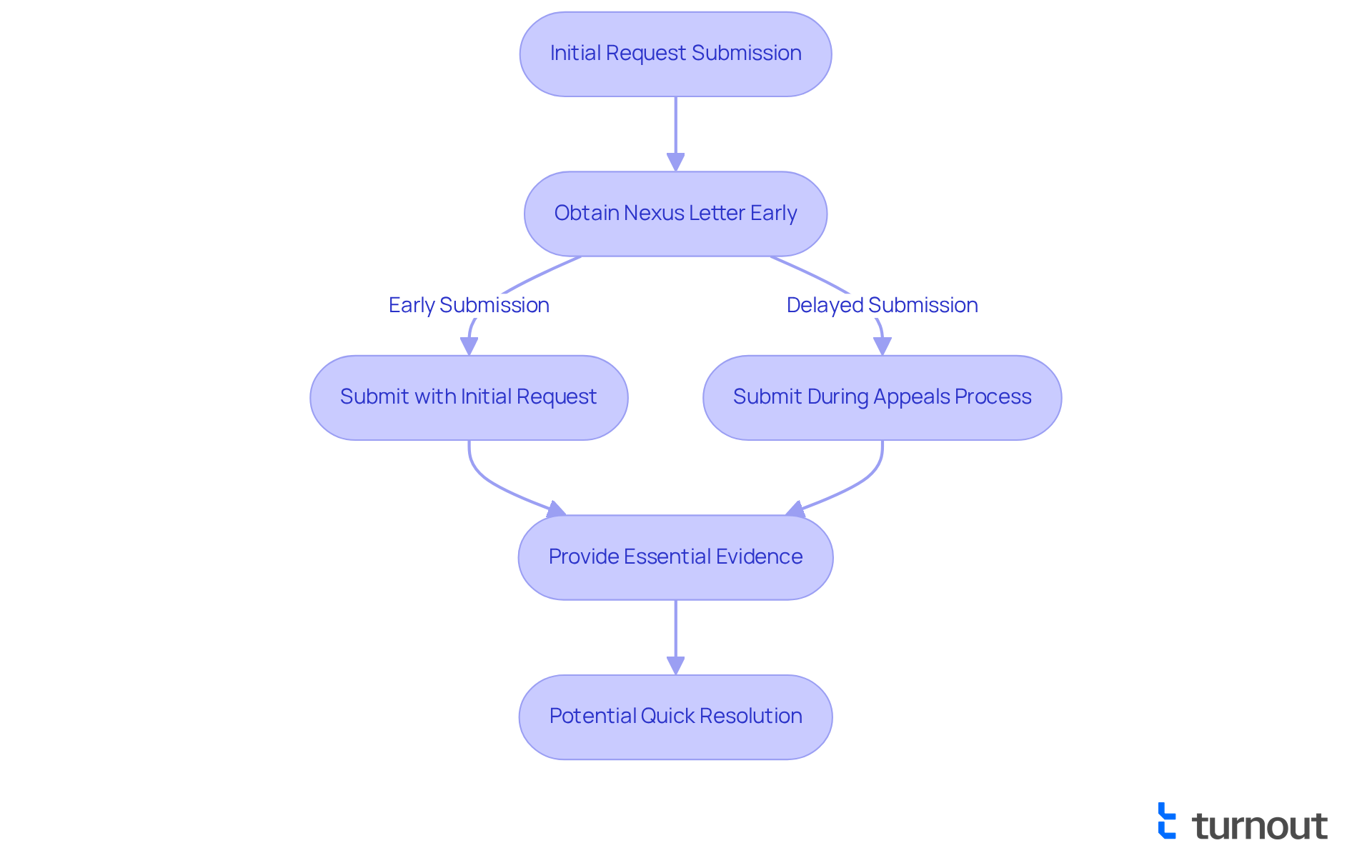
Qualified Professionals: Who Can Write Your Nexus Letter?
A nexus letter must be crafted by a qualified healthcare expert, such as a medical doctor (MD), doctor of osteopathy (DO), or a licensed psychologist. We understand that navigating this process can be challenging, and it’s crucial that these specialists have experience addressing your specific condition and possess a comprehensive knowledge of the VA's documentation criteria. The reliability of the author is essential; documents from experts who understand VA standards are more likely to be accepted.
Consider this: a thoroughly prepared nexus letter can significantly influence the acceptance of a servicemember's disability request. It acts as a vital piece of evidence in the application process, underscoring the importance of having the right nexus letter for support. Additionally, the VA requires the opinion to meet the standard of 'as likely as not,' indicating a 50% or greater probability of service connection.
Nexus documents can vary in length from one to 25 pages, and the cost of obtaining one can range from $400 to $2,000 or more, depending on the complexity of your case. We encourage veterans to seek suggestions from fellow veterans or consult with VA advocates to find qualified professionals who can effectively assist with their claims. It’s important to note that many family doctors may not feel comfortable writing supporting documents due to a lack of expertise in meeting VA standards.
Lastly, it’s crucial to mention that VA doctors cannot draft connection documents due to a conflict of interest. Remember, you are not alone in this journey, and there are resources available to help you through the process.
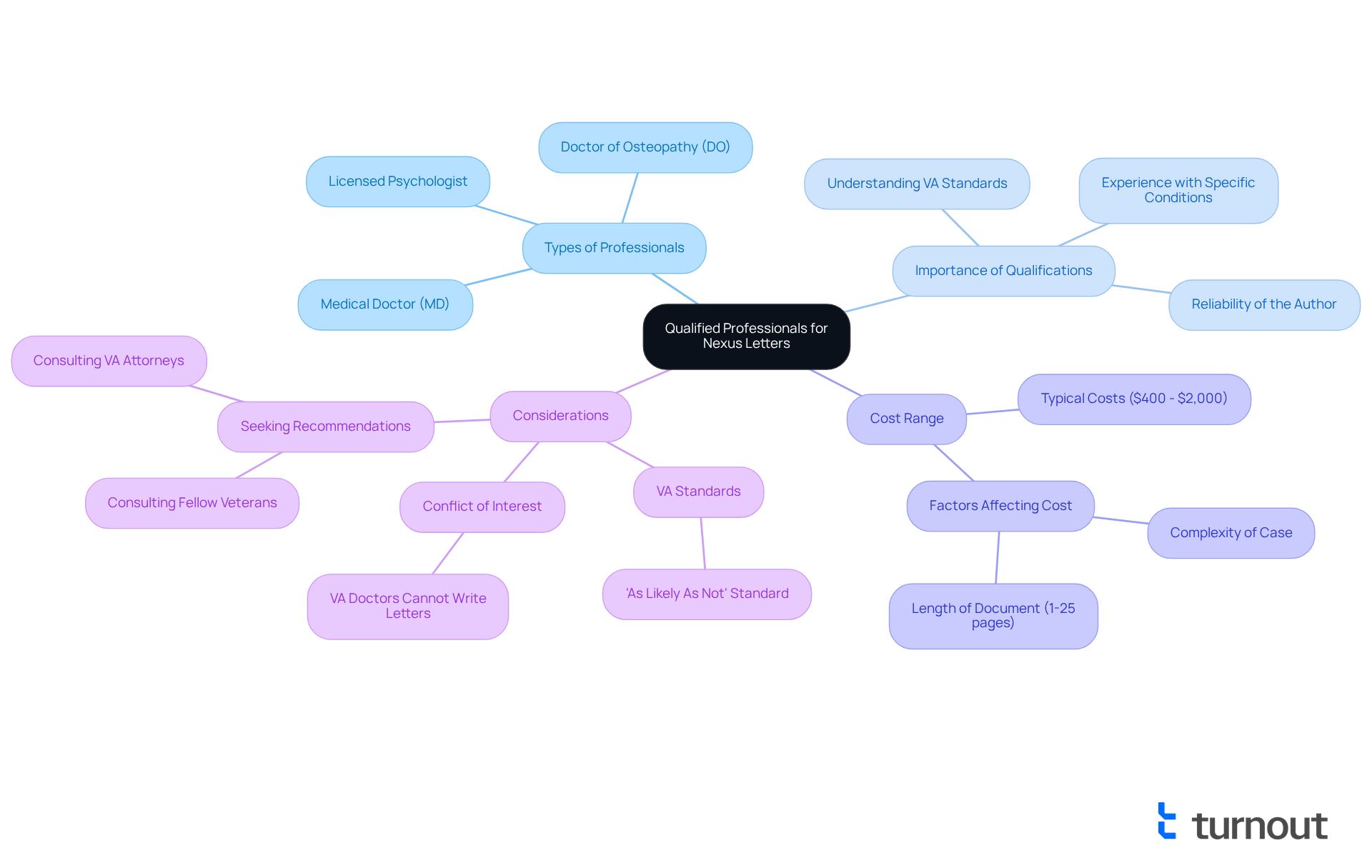
Cost Considerations: How Much Does a Nexus Letter Cost?
Navigating the expense of acquiring a connection document can be daunting. Costs can fluctuate significantly, typically ranging from $500 to $3,000, with an average cost around $1,500. It's common to feel overwhelmed by the factors influencing this range, such as the complexity of your case and the provider's expertise. For example, some providers may charge as little as $100 to $500 for straightforward cases, while more intricate situations can lead to fees exceeding $2,000.
We understand that as former service members, you may be seeking options for complimentary or discounted nexus documents. Nonprofit organizations and your VA healthcare providers can be valuable resources in this journey. Additionally, many providers offer payment plans or sliding scale fees based on income. It's essential to ask about costs in advance to prevent any unexpected expenses.
Nexus letter fees typically encompass services like:
- Initial consultations
- Medical record evaluations
- The creation of the nexus letter itself
This can help you understand what you are paying for, providing clarity in a complex process. Moreover, if you require expedited services, be aware that this can increase the overall expense by $200 to $1,500. This is a significant consideration for those who need urgent support.
Understanding these financial factors can empower you to make informed choices as you pursue the necessary documentation for your VA disability requests. Remember, you are not alone in this journey. We're here to help you navigate these challenges.
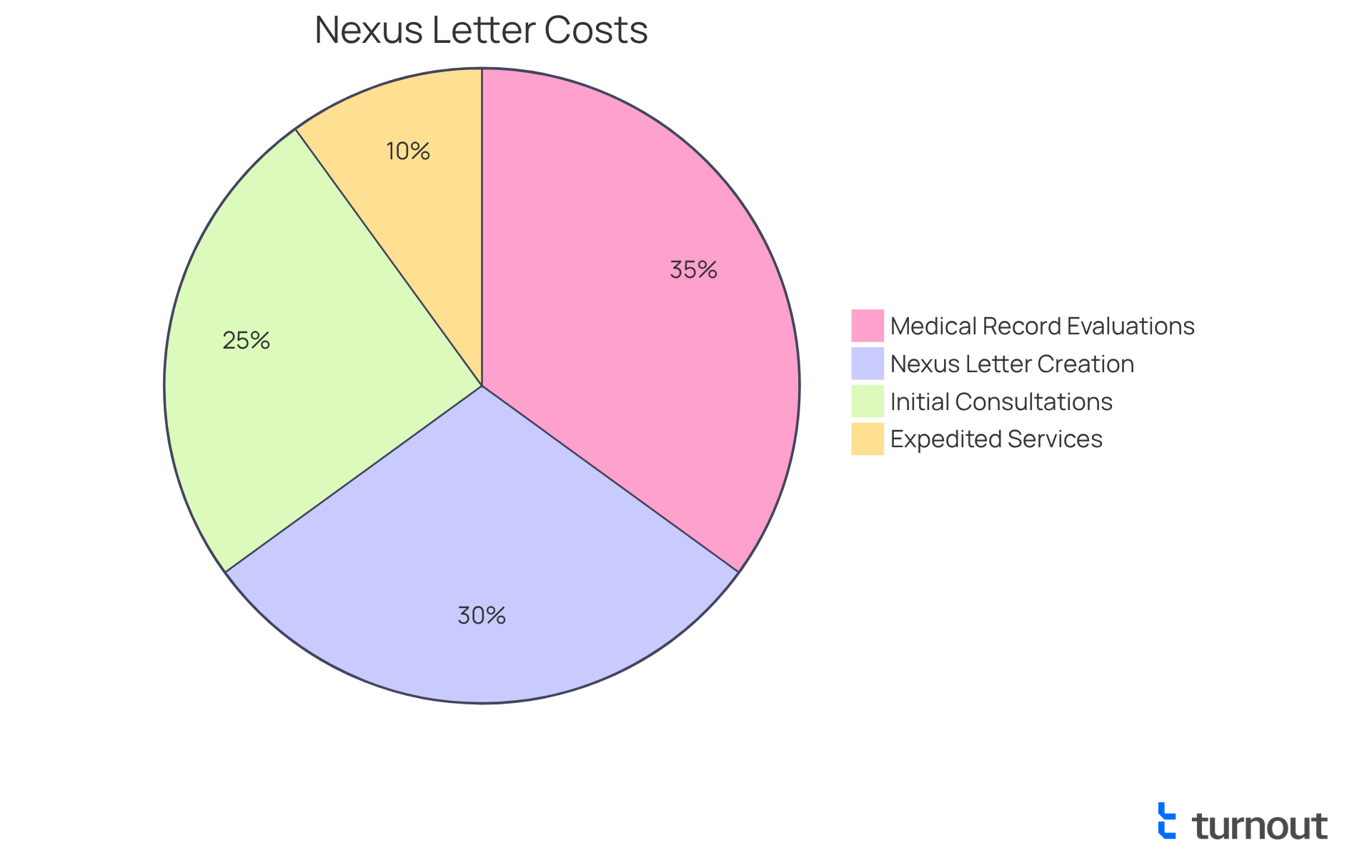
The Process of Obtaining a Nexus Letter: Step-by-Step Guide
Securing a nexus letter for your VA claims can seem daunting, but by following these essential steps, you can simplify the process and feel more confident in your journey:
-
Identify a Qualified Healthcare Provider: It’s important to seek out a licensed medical professional who understands VA processes. Their experience is vital in creating a compelling connection document that supports your claim.
-
Gather Relevant Medical Records and Documentation: Collect your medical history, including service treatment records and any post-service medical documentation that can bolster your case. This preparation can help your provider understand your situation better.
-
Schedule an Appointment: Arrange a meeting with your chosen provider to discuss your current medical condition and how it relates to your military service. We understand that this step can be stressful, but it’s an important part of the process.
-
Request the Connection Document: During your appointment, kindly ask for the connection document. Make sure the provider knows how crucial it is to link your condition to your service. Your clarity can make a significant difference.
-
Examine the Document for Precision: Before submitting, thoroughly check the document for any errors or unclear wording. A well-organized connection document should affirm that it is 'at least as likely as not' that your military service caused or worsened your condition. It’s wise to review your nexus letter with help from a VSO or legal advisor to ensure it meets VA standards.
By following these steps, you can enhance the quality of your request and increase your chances of acceptance. Remember, while a connection document is not mandatory for VA submissions, it can provide essential proof linking your military service to your current disabilities. A strong connection document is often the missing piece in securing the benefits you deserve. With over 2 million veterans assisted in obtaining their entitled benefits through the VA process, knowing how to acquire a connection document can be crucial when submitting your claim. You're not alone in this journey; we're here to help you every step of the way.
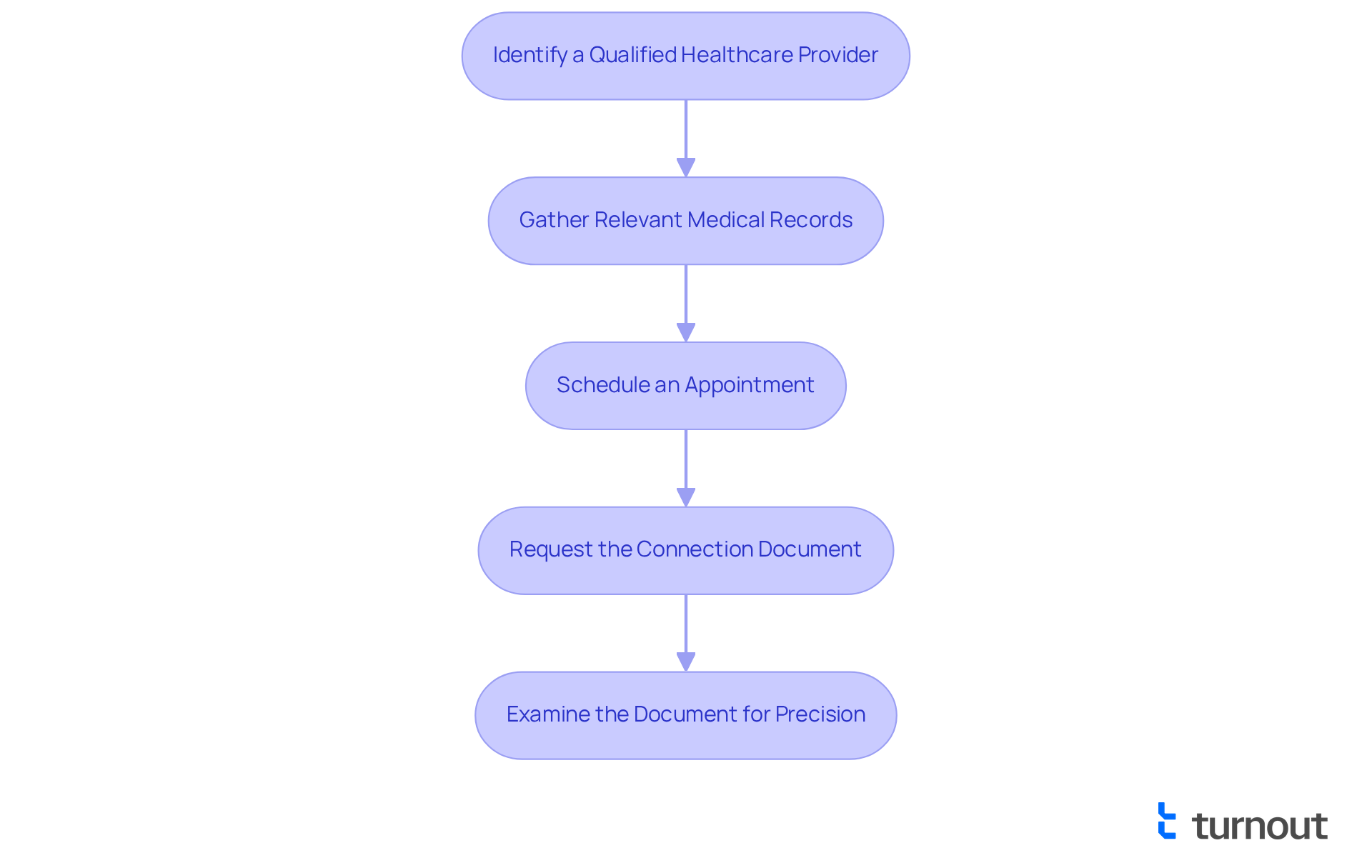
Challenges in Securing a Nexus Letter: What to Watch Out For
Veterans often face significant challenges when trying to obtain a nexus letter. You might struggle to find a qualified provider, encounter hesitance from doctors to write the nexus letter, or worry about meeting VA standards. We understand that this process can feel overwhelming.
It's essential to communicate openly with your healthcare provider about the purpose of the correspondence. Be sure to provide them with all necessary documentation to assist in this process. Remember, you are not alone in this journey, and we're here to help you navigate these obstacles.
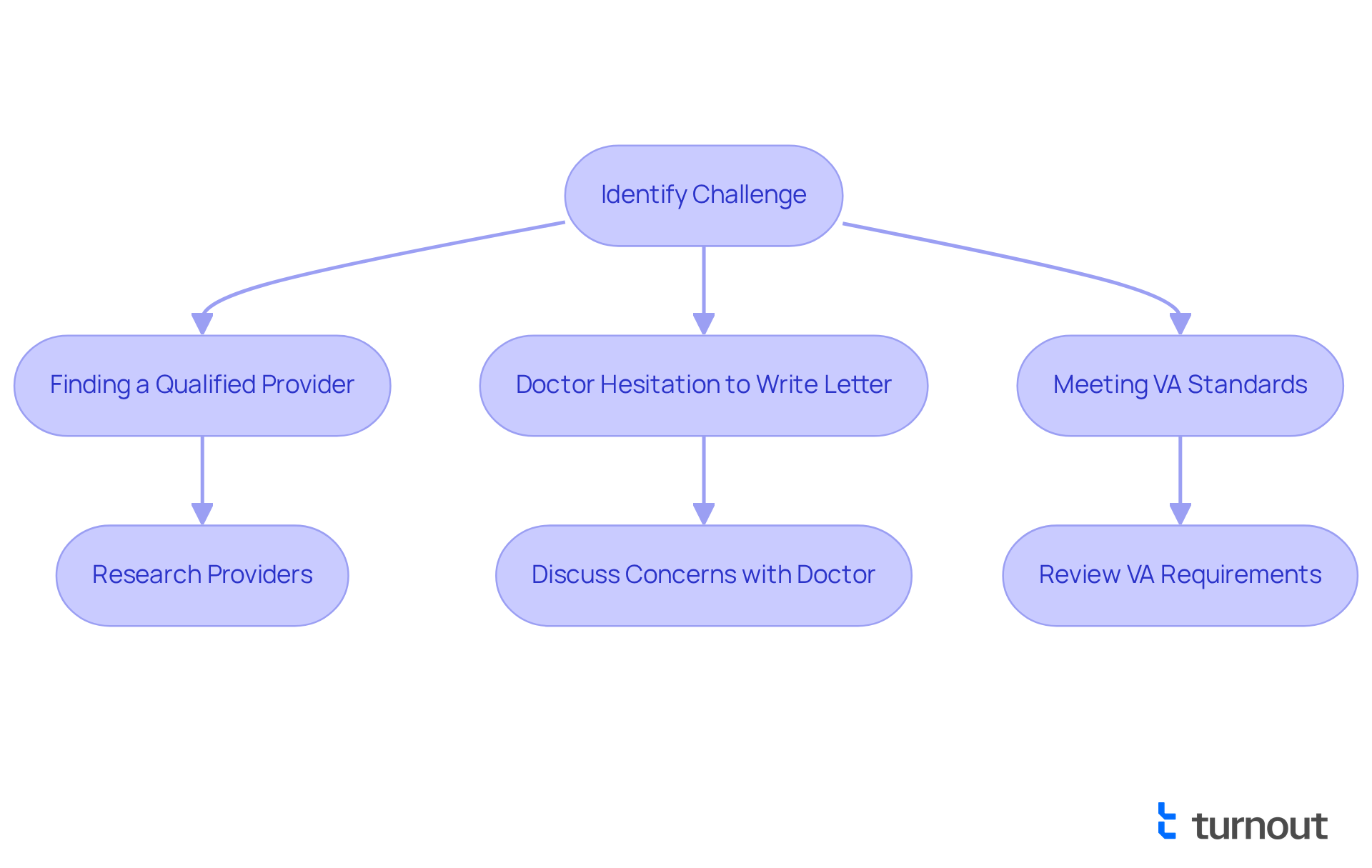
The Role of Nexus Letters in VA Disability Claims: Why They Matter
Nexus letters play a vital role in VA disability requests, offering the necessary medical perspective that links your current condition to your military service. We understand that navigating this process can be overwhelming, and without a solid connection document, you may face challenges in substantiating your requests. This can lead to frustrating rejections or delays.
A well-prepared nexus letter can significantly enhance your chances of a successful claim. It’s not just a formality; the nexus letter is a crucial element of your application process that can truly make a difference in your journey. Remember, you are not alone in this. We're here to help you every step of the way.
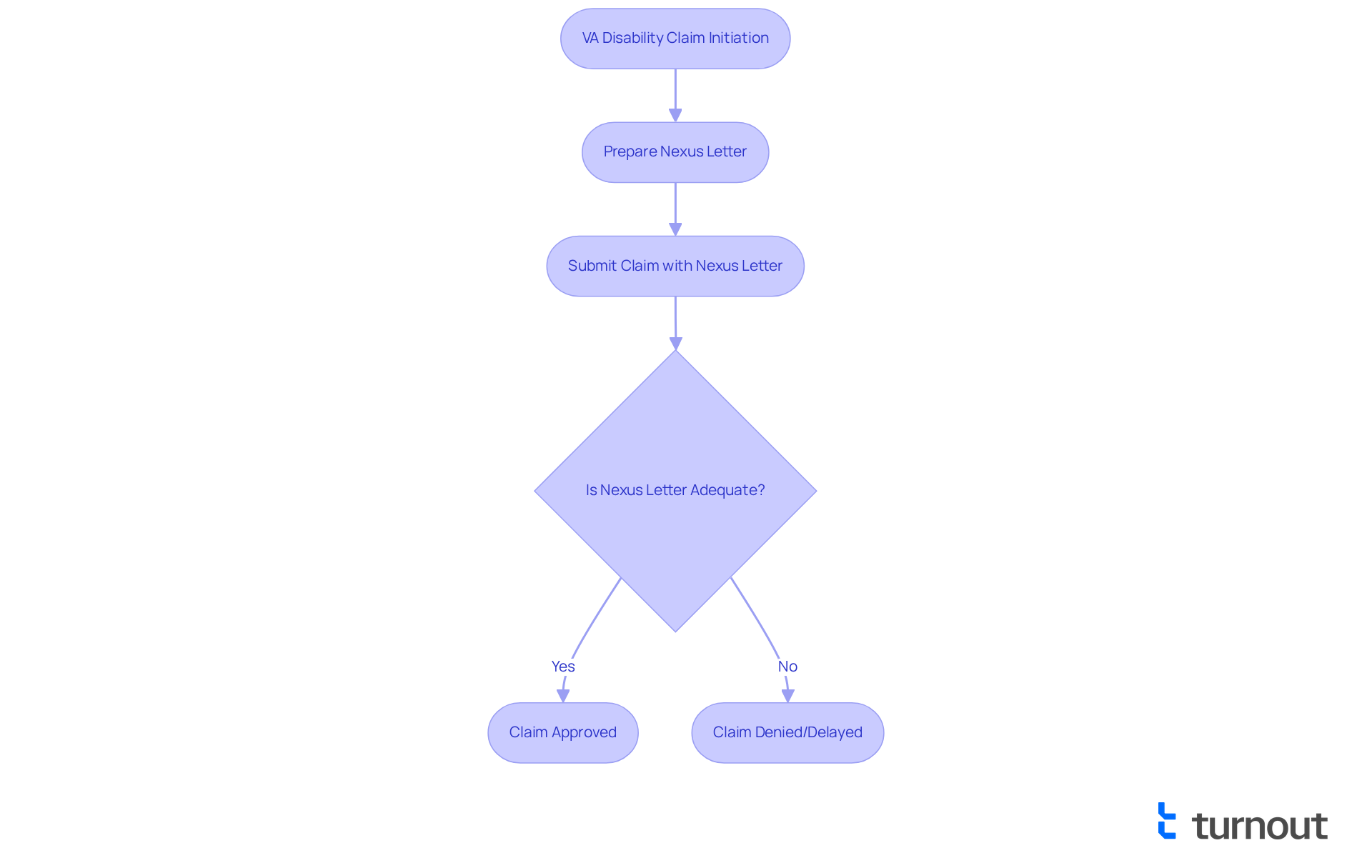
Nexus Letter FAQs: Common Questions Answered for Veterans
We understand that navigating the world of connection documents can be overwhelming for veterans. Here are some frequently asked questions that can help clarify this important process:
-
What is the aim of a connection document? A nexus letter establishes a vital link between a veteran's current medical condition and their military service. This connection is essential for obtaining VA disability benefits. In 2023, the Veterans Benefits Administration authorized more than 1.9 million disability compensation and pension claims for Veterans, highlighting the importance of these documents in the claims process.
-
Who is able to compose a connection document? Qualified healthcare providers, such as primary care doctors, nurse practitioners, and independent medical specialists, are able to compose connection documents. It's crucial to choose someone who is familiar with VA regulations. While chiropractors can also write these documents, their opinions should be supported by medical evidence. Additionally, VA physicians typically cannot write connection documents to avoid conflicts of interest.
-
How much does it cost? The cost of a connection document can vary significantly, usually ranging from $500 to $2000 or more, depending on the provider and the complexity of the case.
-
When should I obtain one? Veterans should consider acquiring a connection document when applying for VA disability benefits, especially if their claim includes non-presumptive conditions or if they are appealing a denied claim.
-
What should be part of a connection document? An effective nexus letter must contain the physician's qualifications, a review of the individual's medical history, a current diagnosis, a clear medical opinion that links the condition to military service, supporting evidence, along with the signature and date of the medical professional.
Finding a qualified provider can be challenging, but addressing these questions can empower veterans to navigate the complexities of the VA claims process more effectively. Remember, you are not alone in this journey, and we’re here to help.
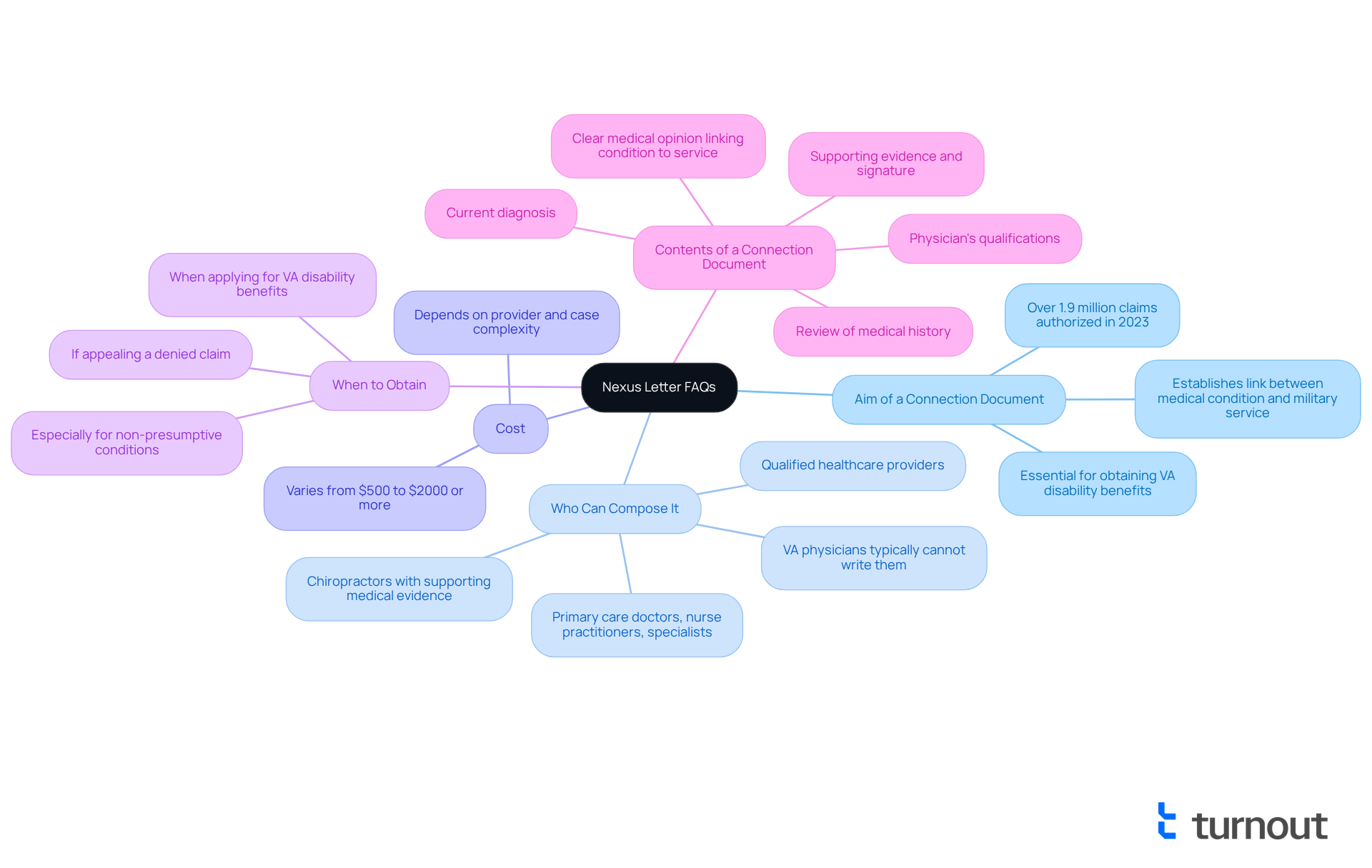
Conclusion
Securing a nexus letter is a vital step for veterans aiming to affirm their connection between military service and health conditions. This essential document not only bolsters disability claims but also serves as crucial evidence in ensuring that former service members receive the benefits they deserve. With the right guidance and support, veterans can confidently navigate this often complex and intimidating journey.
Throughout this article, we've highlighted the importance of a well-crafted nexus letter. We've discussed its key components, the significance of timing in obtaining one, and the necessity of seeking qualified professionals for its creation. Understanding the associated costs and potential obstacles can empower veterans to make informed decisions and streamline their application process. By following the outlined steps and utilizing available resources, veterans can enhance their chances of a successful claim.
Ultimately, the journey to securing a nexus letter is not one that veterans must face alone. Organizations like Turnout provide innovative solutions and support, encouraging former service members to take proactive steps in their pursuit of benefits. By prioritizing the acquisition of a strong nexus letter, veterans can navigate the VA claims process more effectively and ensure that their sacrifices are recognized and honored. Remember, you are not alone in this journey; we’re here to help you every step of the way.
Frequently Asked Questions
What is the purpose of a nexus letter for veterans?
A nexus letter is a formal medical document that establishes a connection between a service member's current health condition and their military service, which is essential for VA disability requests.
Why is a nexus letter important for VA disability claims?
A strong nexus letter provides necessary evidence to support the claim that a veteran's health condition is related to their service, significantly enhancing their chances of receiving benefits.
What challenges do veterans face in obtaining a nexus letter?
Many veterans struggle with obtaining a nexus letter due to doctors' busy schedules, which can lead to denied claims if the letter is absent or improperly composed.
How can Turnout assist veterans in acquiring a nexus letter?
Turnout streamlines the nexus letter acquisition process by integrating AI technology and dedicated advocacy, helping veterans navigate the VA system more efficiently.
What are the key components that should be included in a nexus letter?
Key components include the identification of the veteran and their medical condition, a clear connection between the condition and military service, the medical professional's qualifications, and supporting evidence from medical records.
How has Turnout impacted veterans seeking benefits?
Turnout has assisted over 2 million service members in navigating the VA process, simplifying workflows and reducing bureaucratic hurdles, ultimately leading to better outcomes for veterans.
What does Turnout offer to enhance the experience for veterans?
Turnout combines AI capabilities with compassionate human supervision to provide essential support and ensure that veterans receive the benefits they have rightfully earned.




